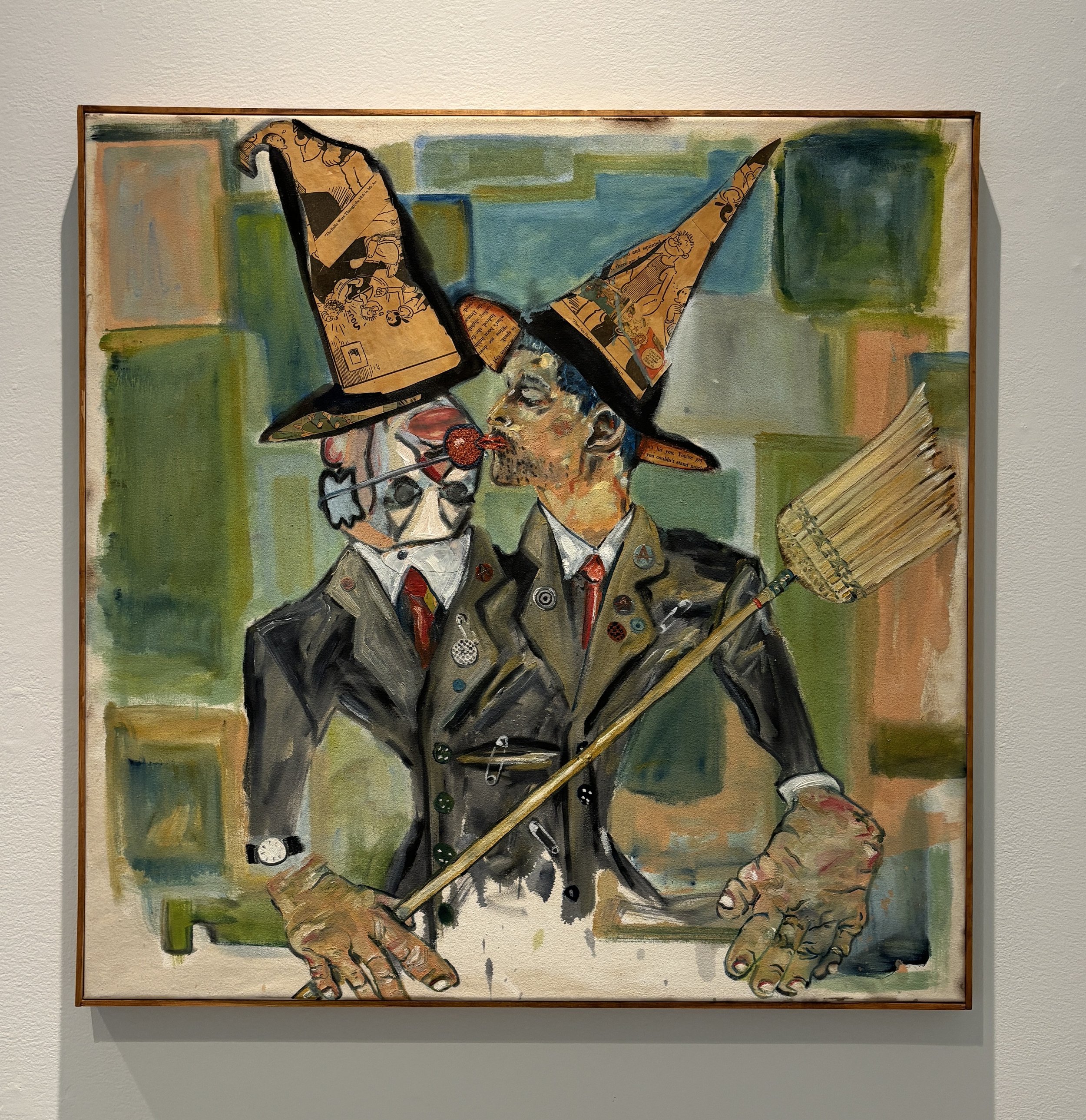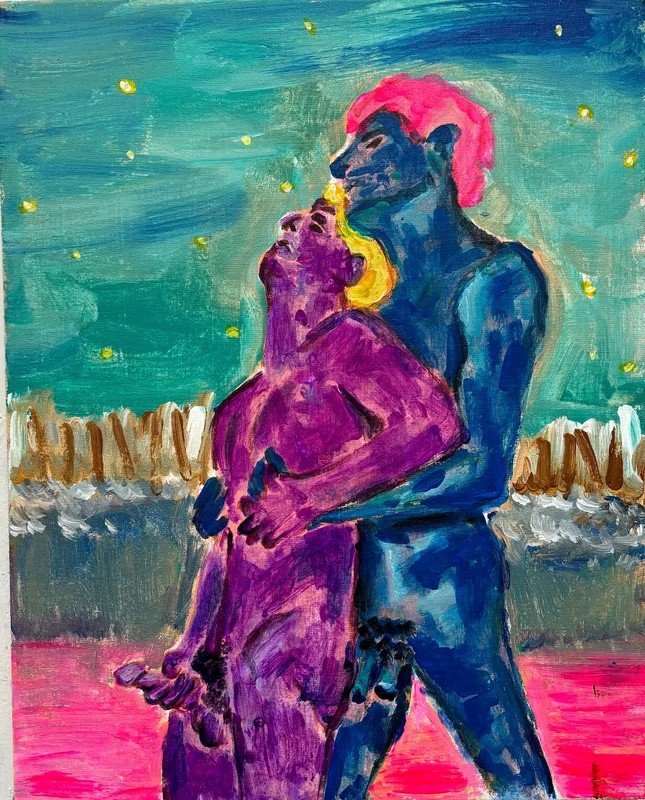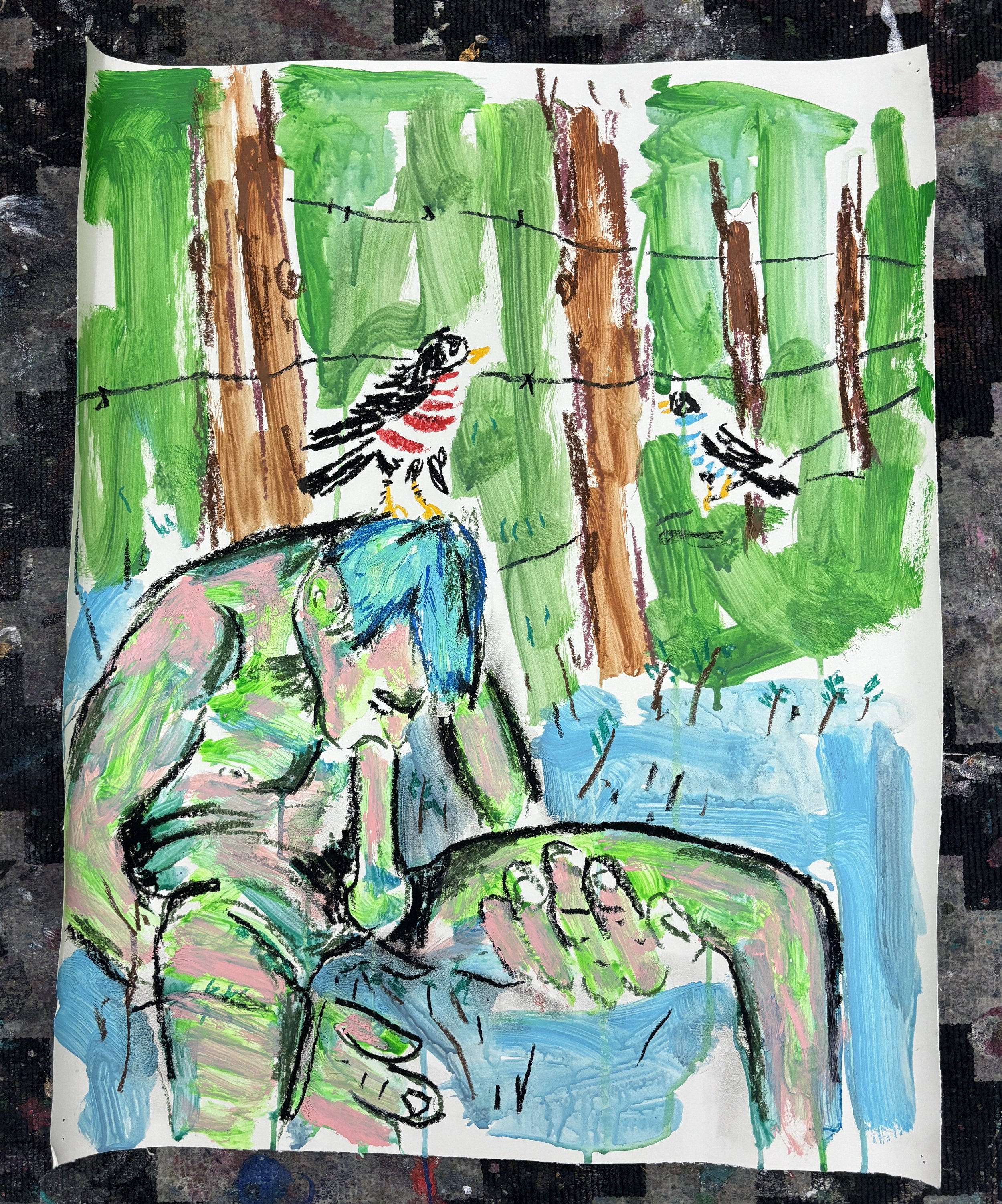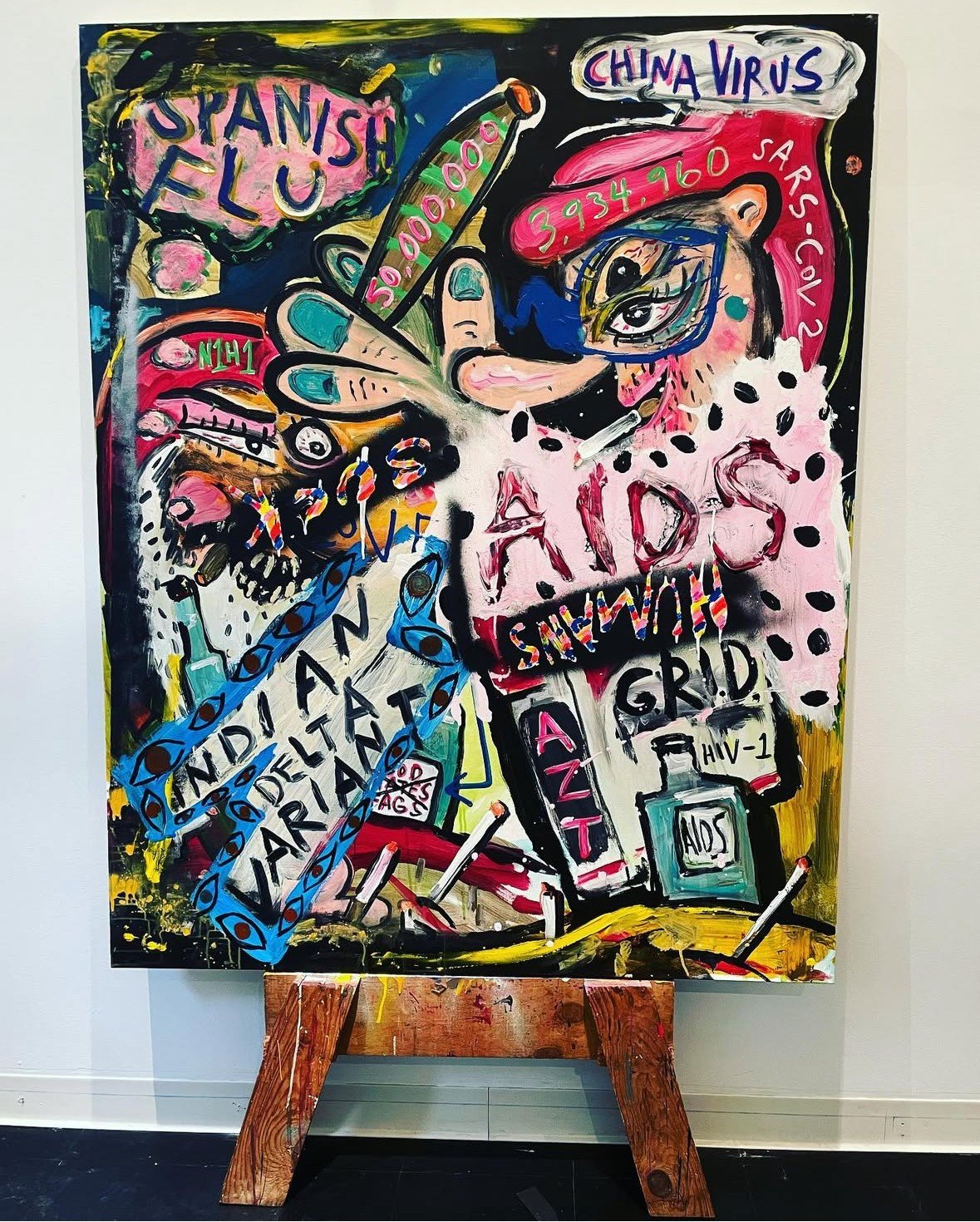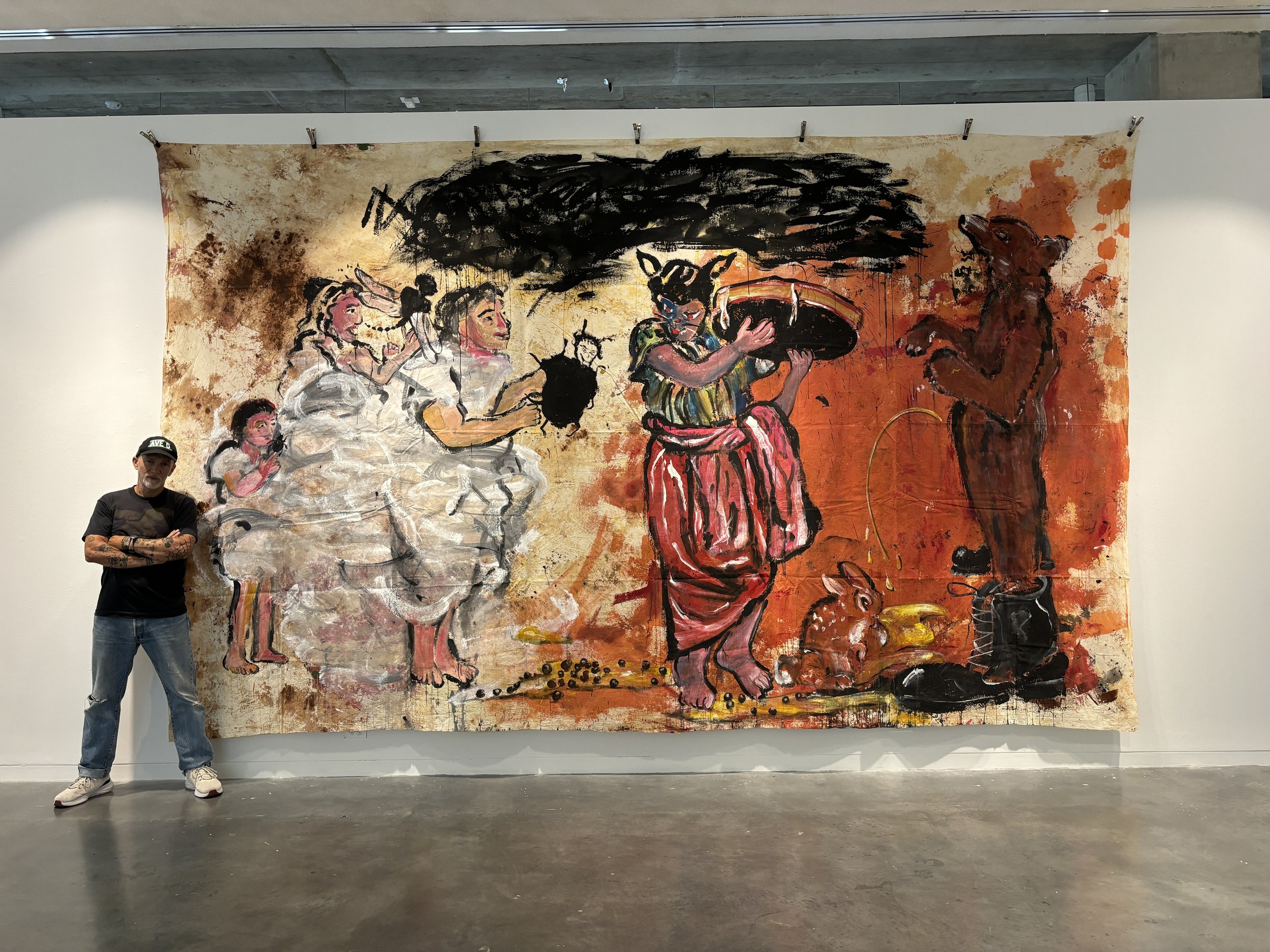beneath and beyond the art: an interview with scooter laforge
by David Estringel
Photo of Scooter LaForge (Photographed by Scott Pasfield)
When the idea for Blood+Honey started to congeal in my head back in March ‘25, I knew I would write a column of some sort, but I had the most difficult time trying to narrow down what, exactly, I would—could-write about on a regular basis. Book reviews were always a viable option. Feature pieces geared toward the literati or obscure, translated novels had some appeal, as well. Still, nothing I came up with really gave me much of a tingle.
Then, during a repeat viewing of Scooter LaForge, a Life of Art ,inspiration struck me like a bolt. It all became exceedingly clear (and tingly): I am going interview Scooter LaForge. Thank the powers that be for my innate Spidey sense (My apologies to all you Marvel fans. Saw the opportunity. Had to take it.)
Obviously amiable, laser-focused on his art (in all its manifestations), a seemingly checked ego, socially conscious, and a tendency to flourish in his collaborative relationship, Scooter exemplifies what many of us creatives strive for, to be when we grow up.
The man has wisdom.
Above all, Scooter has been through some shit. Like most queer boys trying to eke out a survival plan during the most vulnerable time of their lives, he knows dark. Every rough spot. Every blemish. More importantly, he survived it all, and he still managed—manages—to transmute trauma and psychic pain into deliciously tangible moments of (savage at times) beauty that often walk the line between resonance and provocation (my favorite flavor).
The man has stories.
My first encounter with Scooter was shortly after I cyberstalked him on Instagram after my initial viewing of his documentary. Overcome with the need to gush (and literally my first ever case of hero worship), I messaged him and lauded his candor and bravery in popping open a vein for all of us to see, for laying his past out without qualm or hesitation. Being a stand up kind of guy, he messaged me back soon after. We exchanged some words about art and our mutual experiences with the AIDS crisis of the early 90s when so many in our community were dropping like flies, when no one seemed to know anything about anything. It was wonderful; I was elated. I walked away smiling at the surprise of this delightful one-off.
Fast forwarding eight months later, I’m messaging Scooter, again, telling him about this cool, new lit mag I was starting and how amazing it would be if he sat for an interview. No convincing necessary, he hopped on board the B+H train, almost as excited as I was.
The man is good people.
Upon pitching the interview to Scooter, I let him know that who he is as an artist/creative, his motivations, his drives were the “good stuff.” These things, after all, are really what make his work so interesting. Plus, what could I possibly ask him about his art that he hasn’t already answered a billion times? Without hesitation, he agreed to a “swim the deep end.” Sex, drugs, suicidal ideation, mental health challenges, bullying, tremendous loss, loneliness, isolation and (of course) poetry were unflinchingly tossed onto the table in a beautiful mess.
And we dove in…
Blood+Honey: Thanks for doing this Scooter. Can’t imaging launching Blood+Honey without doing an interview with you about your art, your journey to now. Let’s do this.
So, you have described your artistic style as being that of Pure Psychic Automatism, which has its roots in the Surrealist Movement, abandoning conscious thought to let the stuff of the subconscious come through. How did you come to first engage with this approach? More importantly, has what manifested for you over the years been more reflection or more revelation? We are never really quite sure what lurks beneath the murk, are we?
Scotter LaForge: Yes, I’ve started painting using the tools of psychic automatism. I first became aware of it about ten years ago, when I was studying the Surrealist movement — especially Max Ernst. My good friend Izhar Patkin is a great admirer of Ernst, and when we were shopping in Venice, Italy, we came across a Max Ernst sculpture in a vintage shop. That encounter made me deeply curious about his work. I dove into the world of Surrealism and fell in love with automatism.
What I love about it is the absence of thought — it’s pure movement. It feels as if the spirit takes over and the hand simply follows, a dance across the canvas.
Over the past few years, the way I create has become a blend of reflection and revelation — looking back on where I’ve been, and opening myself to what wants to emerge.
I often reflect on my formative years in San Francisco. I moved there in 1989, during the height of the AIDS epidemic, when San Francisco still felt deeply magical. Living there, I felt like a character in Armistead Maupin’s Tales of the City. Those ten years shaped me as a gay man, and I’ll never forget them.
All of my faggot witch sisters are still there, still making magic. I eventually picked up and moved to New York in 2001.
Blood+Honey: And brought some of your own special brujeria with you. Can’t ever have too much of that.
Siamese Witches (2008) by Scooter LaForge
Blood+Honey: As gay men (of a certain age) in 2025, we have lived—are living—during times of great trauma and uncertainty: coming out; homophobia; bullying and violence (in all its forms); the AIDS epidemic and the resulting deaths of loved ones and friends; heterosexism; heteronormativity; culturally-endorsed, machisto paradigms; drug culture; ageism; 9/11; COVID; systematic erasure; and so forth. For some, life’s constant bombardment threatens to diminish their creative sparks. How have you managed to keep your passion to create and manifest alive amidst all the din and chaos?
Scotter LaForge: I lived through all of it. I was in San Francisco at the peak of the AIDS epidemic. I’ve got a sharp memory — I remember everything: details, faces, words, deaths from Kaposi’s sarcoma, overdoses. It all feeds into my work.
San Francisco gave me memories of life and death, joy and sadness, love and loss. I spent a lot of time in the Castro and on Polk Street, where many came to the city and were gone just months later. These memories are like a library in my mind and come out onto the canvas, sometimes without me thinking about it. It’s a history book.
I’m proud to have lived through it. I love gay history and culture. We bring color to the world. We are the music makers, the dreamers of dreams, to quote Arthur O’Shaughnessy. My work is here to remind people what it was like, in case they forget.
Blood+Honey: True that. Reminds me of a poem, “The End and the Beginning,” by Wisława Szymborska about the futility of war and our propensity to forget our traumas. There are the few though—the record keepers—that never forget. In essence, that’s artists (writers included) are tasked to do by the very nature of their art, isn’t it? Preserve the narratives any way they can so they don’t get lost to time, or indifference? Painful, but an honorable duty nonetheless.
Endless Summer Night (2023) by Scooter LaForge
Blood+Honey: Creatives are no strangers to exploring themes of trauma and sexuality in their works; it comes about as naturally as breathing or seeking to discover rhythm within discord. How has the expression of these themes evolved in your work as your physical and creative “selves” have matured?
Scooter LaForge: Trauma and sexuality are universal experiences that all human beings share, regardless of who they are. These themes have shaped my work since I was six years old. When I moved to San Francisco, I became sexually active, and there were many parties, sex clubs, and gatherings. Despite being financially struggling at the time, sharing experiences of pleasure was free.
That time was dangerous, but it was also free, and in many ways, it still is. I love painting about sex and trauma. These are subjects that every human being can relate to. I’m not afraid to explore them. Sex has brought a lot of joy, while trauma has brought sadness. The combination of the two makes for powerful, meaningful artwork.
Fairies at the Pond (2023) by Scooter LaForge
Blood+Honey: One of the many salient elements of your art is the unapologetic celebration of queer life and homoeroticism. Sometimes straightforward (for a lack of better term), while at other times more abstract, one never really gets the impression that these images are provocative for their own sakes. Whether it be a piece like “Sissy” or images of threesomes, golden showers, phalluses, or auto-fellatio, the presence of a “silenced narrative” makes itself known, bringing to light a “shadow life,” un-shaming the “shameful.” What pieces of you (past and/or present) drive the voice behind the narrative, the storytelling, the reclaiming?
Scooter LaForge: The celebration of queer life — what a powerful idea. This is how I will live the rest of my life. All of my sexually charged paintings have come from personal experiences. For example, Auto Hook, the auto-fellatio painting, was inspired by a lover I had shortly after moving to New York City. This man was incredibly beautiful, and I was so captivated by how effortlessly he could perform, I had to capture that moment on canvas.
Another painting depicts three "devils" in a three-way, with me and two other men after a night of ecstatic dancing and GHB at Club Universe. These kinds of experiences were common for me, and they remain unforgettable. The men were so beautiful, so muscular, with chiseled faces and stunning bodies. The energy, the lips, the mouths — each person went wherever they wanted, and I did the same. Those days are vivid in my memory, and I am grateful for those experiences.
Sissy came from trauma I experienced in high school. That’s what everyone called me, and I was bullied a lot. I was beaten up, made fun of, and ridiculed often. It was a nightmare. I even tried to take my life three times in high school through gas asphyxiation. Thankfully, none of those attempts succeeded, but if you look at my high school diaries, you’ll see a deeply sad teenager with no will to live, no gay role models to turn to, and feeling entirely isolated. I was hated by everyone at school. I couldn’t wait to escape my hometown, much like the small-town boy who dreams of moving to San Francisco. For me, San Francisco was the end of the rainbow, a symbol of achieving something extraordinary, and New York City felt like the pot of gold — the ultimate reward.
Sunset (2009) by Scooter LaForge
Blood+Honey: I think you’ll agree that things happen in all our lives that forever shape us (for the good, the bad, or both). As a creative, if you had to narrow these down to just a few moments, which have impacted your art the most and how? I am especially curious to know how the “Covid Cave Painting” you created during quarantine shifted things for you, artistically.
Scooter LaForge: Living in San Francisco shaped my life; those were my formative years, from 1991 to 2001. I learned a lot, went through a heavy cocaine addiction, and eventually got sober. I saw so many people die of AIDS and was there at the height of the epidemic. I was one of the first members of ACT UP. I remember people like Jerome Caja, Justin Vivian Bond, Diet Popstitute, Juanita More, Heklina, Pippi Lovestocking, and many others who played important roles in shaping my life. I was even roommates with Emma Peel, who later became a major figure in the San Francisco scene.
The Corona Cave paintings came about during the pandemic. I was locked in my apartment for those months and had only a few colors of paint and brushes stored under my sink. I pulled them out and started painting the walls. I was deeply inspired by Goya’s Black Paintings, which he painted all over his house. This had a strong impact on me. Since then, I’ve been painting rooms with my good friend Izhar Patkin. Currently, I’m repainting a room inspired by the Bloomsbury Group, particularly moved by the works of Duncan Grant and Vanessa Bell.
Blood+Honey: They really are quite amazing. A true testament to your adaptability and perseverance as an artist, I am sure.
God Hates Fags (2020) by Scooter LaForge
Blood+Honey: So, I have always love the concept that works of art are already formed in the ethereal before they manifest, waiting someone to come along and reveal them in the physical world, for example, via the blank canvas or lump of clay—a concept you seem to be familiar with. Adhering to this idea, to what extent does the artist—do you—rely on intuition as an instrument to realize true vision (art)? What did—does— the process of “getting there” look like for you in terms of concept development and execution? Trusting yourself, artistically, is a challenge in and of itself, no?
Scooter LaForge: Yes, this is a great concept. When I stare at a blank canvas, a blank piece of paper, or an empty room and wall, it feels as though the work is already done. For me, creating is like a dance — I start and stop. I take breaks, rest, and come back. It’s like being at a disco, going to the bar for a drink, then returning to dance when your favorite song comes on. This process is fluid, especially when we paint rooms. We start and stop. We have a general idea of what’s going to happen, but it always changes. I love this process. I love spontaneity. I have the freedom to change my mind whenever I want, to go in a different direction if I choose. I think the job of an artist is to be free: to follow intuition and have fun.
Masters of the Universe (2008) by Scooter LaForge
Blood+Honey: Let’s talk failure. You have said in the past that failure is one of the best things that can happen to someone. Will you elaborate? How has failure helped you become the successful artist you are today? Any advice for would-be creatives out there in that respect?
Scooter LaForge: Failure. It’s the best thing that’s ever happened to me, both personally and artistically. I remember back in the early 2000s, I was dating a wonderful man. The relationship wasn’t quite working, and we ended up failing at it. Later, he told me I needed help, that I should see a therapist. It stung and hurt, and I took it personally, but looking back, it was one of the best things that ever happened to me.
Failing at paintings is the same. I try something, it doesn’t work, and I simply throw that failed piece aside and start over. I’ve learned not to repeat the same mistakes. I know what colors to use first, that layering comes after laying the base, and so on. Painting is a never-ending learning process, and that’s what makes it so much fun for me.
To the would-be artists: never stop painting. You’ll be your best teacher. Visit museums, hang out with other artists. It’s important to have what I call an “army of love” — other artists, dancers, writers, actors, singers, poets, who support and uplift you. We all inspire each other to ascend and become better artists!
James, Will You Be My Girlfriend? (2018) by Scooter LaForge
Blood+Honey: In your Homo Eruptus show at Howl Happening NYC (2019), your work centered around the erotic, fresco paintings of Pompeii (79 A.D). The metaphorical ‘black cloud’ is one element of that work that still sticks in my head and refuses to leave. I think you were correct in suggesting ‘the cloud’ means different things to different people (such is the power of metaphor’s abstract nature). Six years later, ‘the black cloud’ still remains relevant, adapting and expanding to encompass the meanings of the times. I see it, now, as the Era of Erasure that currently looms over many of us—far enough to make its effects almost invisible to the naked eye, but close enough to detect its stink. What does ‘the black cloud’ mean to you right now?
Scooter LaForge: The black cloud in one of my paintings from Homo Eruptus represents both the ash and dust expelled by a volcano and serves as a metaphor for death — the fate of those in Pompeii. This black cloud has appeared in different forms in my life, notably during the AIDS epidemic and COVID-19. In today’s world, we can choose whether or not to live under that black cloud. For me, I choose not to.
I’m used to following the sun, seeking out the things that bring me joy. I love reading! Right now, I’m revisiting Tales of the City by Armistead Maupin, and I’m also reading The Faggots and Their Friends Between Revolutions by Larry Mitchell, with beautiful illustrations by Ned Asta. I also recently finished Harsh Cravings by Jason Haaf, a book I randomly picked up at The Strand bookstore. After reading it, I reached out to him to let him know how much I enjoyed it, and now we’re collaborating on a special art project that combines his writing and my artwork.
Reading these books takes me to another world — one that’s happier and freer, a queer world where people are free to be themselves. I’m free right now. I’m lucky that my job is to spread color in various places. I recently went to Palm Springs and spread a lot of color there. Next week, I’m heading to New Mexico to splash color on a bathroom wall, and then I’ll leave. Currently, I’m painting a Bloomsbury-style room at my friend’s house. We’ll finish that up, and then I’ll leave. I love leaving marks everywhere — little historical nods.
Blood+Honey: Since Blood+Honey is above all a lit mag, I would be remiss if I didn’t inquire about who you are reading now. More importantly, what works of literature have impacted your art most?
Scooter LaForge: Right now, I’m really into gay love stories. I’m currently reading a few books and have just ordered some more — all gay! Here’s a list of the books I’m reading, have been inspired by, and plan to read in the future: The Complete Short Stories by James Purdy, Lie with Me by Philippe Besson, and On Christopher Street: Life, Sex, and Death after Stonewall by Michael Denneny.
Blood+Honey: Maurice by E.M. Forster is always a good go-to; it’s been mine for decades, since undergrad. An Edwardian tale of gay love and acceptance that transcends social class and the law of the land. It doesn’t end with either guy coming to some horrific end or committing suicide, actually. It was quiet the trailblazer during in its time. Still is.
Scooter LaForge: Absolutely. It’s been on my list for a while now.
Blood+Honey: Right on, Scooter.
So, it’s my understanding that you are no stranger to writing poetry. As someone who is better known for his work in the studio arts, what inspired you to put pen to paper (does anyone do that anymore?) and write poetry? What was that process like and are you still writing poetry today? Care to share a favorite of yours? Subs are always open, btw.
Scooter LaForge: In college, I took a creative writing class and did very well. It was inspiring, and I started writing stories. Then I picked up a paintbrush, and I haven’t put it down since. I carry a journal with me everywhere and write down my thoughts, inspiring passages, and little short stories about my comings and goings in the world — and the strange situations I’ve found myself in and how I’ve handled them. Lately, I’ve become friends with a brilliant poet named Helixx C. Armageddon, who inspired me to start writing poetry again. I’ll share some of my poems with you — here’s one, and I’ll send more at another time.
-------------------
Poem:
Golden Spill
I catch the flicker in your eye,
the pull of its quiet shadow.
When we first met — a spark,
an energy I couldn’t name.
Nine months later, I’m still chasing it.
We floated once,
clouds beneath our feet,
but now the earth calls louder.
Doubts creep in —
am I enough, am I ready,
be careful what you wish for.
Still, I rise.
You speak of contrary actions,
contrary actions...
but it’s never that simple.
I miss the stillness of numbness —
even pain had its quiet rhythm.
We argue, then laugh,
building a place that feels like ours,
imperfect, yet home.
We spill into each other,
golden, tangled.
I fall, I rise,
again and again.
You want to be a boy, I want to be a boy;
you want a man, I want a man —
we’re both, all at once.
We rise together,
toward the sun.
Our clothes are simple,
our smiles full,
love asks for nothing.
I feed, you drink —
it’s enough.
All I know is I’m here,
beside you,
holding steady.
Blood+Honey: Beautiful. Love a fix of vulnerability with a touch of longing bubbling just beneath the surface. Another one of my favorite flavors.
------------------------------
Blood+Honey: So, I know I pitched 10 questions, but I have to ask: The auto-fellatio imagery…a metaphor for self-love and self-acceptance or just hot?
Scooter LaForge: That painting is based on my life when I first moved to New York City. I met someone on Manhunt, and we’ve been friends with benefits for many years. I took a photo of him doing auto-fellatio, and the painting represents the loneliness I felt at that time. It also holds different meanings for different people. I created it while feeling isolated in a city as vast as New York. Despite being surrounded by so many people, I felt alone. The painting also reflects self-love — the importance of taking care of ourselves, having fun, and nurturing ourselves physically, mentally, and emotionally. You know what I mean?
Blood+Honey: Intimately.
Auto-Hulk (2007) by Scooter LaForge
Blood+Honey: Thanks for taking the time to sit and answer our questions so candidly, Scooter. Couldn’t have asked for a better first interview or a better way to launch B+H. We love your layers and your art. Never stop. Also really looking forward to seeing the rest of those poems. So, given that, I’ll just say, “Until next time,” for now.
By any stretch of the imagination, Scooter LaForge is a success. Madonna, Beyonce, and Nicki Minaj have worn his fashion; he has collaborated with notable names in fashion, such as Walter Van Beirendonck, JCRT, and Patricia Field of Sex and the City fame; and he’s a much sought after artist that works, works, and works with no indication of slowing down. Still, while all of his accomplishments are undeniably impressive, I posit that his success cannot wholly be defined by these things.
Scooter LaForge is an ol’ school survivor. He’s suffered the slings and arrows that life has hurled toward him, licked his wounds, and adapted with the times with finesse and grace. He’s accomplished all he has, despite the challenges laid out before him , and used his traumas to bring some much needed beauty into this world. No easy task.
In a recent email to Scooter, over some trauma bonding, I stated that the horrors of childhood are so tenacious and have tendencies to linger. My inner child has done his fair share of bellowing, still does from time to time, but now he claims his space with words (verse and prose). Scooter’s uses words, paint, sculpture, fashion, and whatever else is within reach to claim his space. He’s a brutal chorus, and one would be hard-pressed to find another melody as sweet.
*Stay tuned for the next monthly installment of Beneath and Beyond coming in June.

